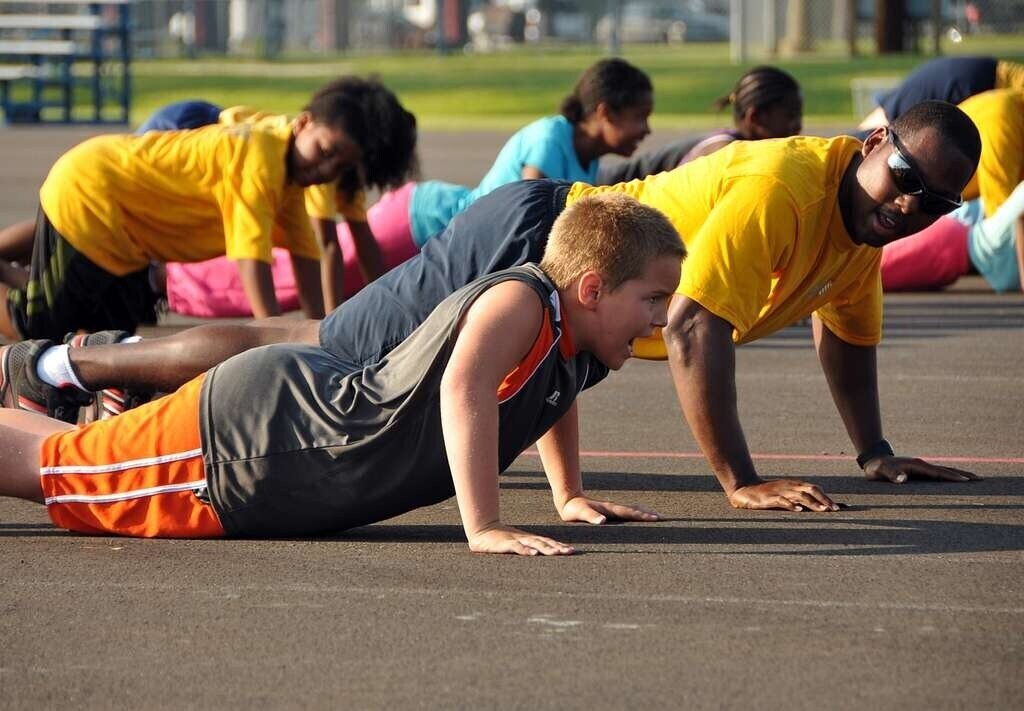Cardiovascular exercises (cardio) challenge and strengthen the cardiovascular system, which includes the heart, the blood and the blood vessels that carry blood to and from the heart. These exercises are a vital part of any fitness for kids program.
From the ages of six to 12, kids need lots of physical activity and fitness to build strength, confidence and co-ordination.
In this article, For Kids will supply you with a list of 25 fun aerobic cardio exercises for kids, which can be done both indoors and outdoors.
There is no need to go to a gym to perform these training exercises.
Fitness for kids: List of 25 cardio exercises for kids of all ages
1. Running in Place
Steps:
- Run in place for one minute, trying as many different running styles as you can imagine, including:
- high knees
- heels kicking your bottom
- wide-leg running
- slow-motion running
If the weather permits, do this exercise outside.
2. Jump Rope, Both Feet Low
Props: A jump rope for each participant
Steps:
- Hold your elbows at your sides while turning the rope with your wrists. Swing the rope smoothly and keep your feet close to the ground.
- As the rope circles towards your feet, jump over it.
- Count how many jumps you can complete without stopping.
3. Jump Rope, Both Feet High
Props: A jump rope for each participant
Steps:
- As the rope circles towards your feet, jump over it while bringing both feet up high.
- Do this aerobic cardiovascular exercise for one minute.
4. Jump Rope, One Foot Only
Props: A jump rope for each participant
Steps:
- As the rope circles toward your feet, jump over the rope by using only one foot the entire time.
- Do this fitness exercise for kids for one minute.
5. Jump Rope, Alternating Feet
Props: A jump rope for each participant
Steps:
- As the rope circles towards your feet, jump over the rope by alternating the leg that is leading each time.
- Continue this exercise for one minute.
6. Scissor Jumps
Steps:
- Begin in a standing position with one foot in front of the other.
- Jump up and switch the locations of your front foot and your back foot.
- Keep repeating this exercise slowly, and then speed up the movement.
- Repeat this movement 20 times.
7. Jump Rope, Scissor Jumps
Props: A jump rope for each participant
Steps:
- As the rope circles toward your feet, jump over it first with your right leg in front and your left leg in the back.
- When the rope comes around again, switch the leg that leads, and keep alternating the leading leg in this way.
- Do this workout for one minute.
8. Jumping Jacks
Steps:
- Jump and land with your feet wide apart
- Jump and land with your feet together.
- Each set of one wide and one feet-together jump counts as one Jumping Jack.
- Do 15 Jumping Jacks.
Variation: To make this more challenging, add an arm movement.
To do this, when your legs are together, your straightened arms should be down at the sides of your legs.
As you jump wide, raise your straightened arms sideways and upward until they are overhead.
Note: Practicing the co-ordination that’s required to use their arms and legs together may take a while for some children.
9. Skipping
Skipping is one of those exercises that all children should learn, although sometimes they have trouble learning to skip at first.
This type of movement helps with co-ordination, rhythm and timing.
For optimum results, practice skipping yourself first and then demonstrate the movement to the
children.
Steps:
- Step forward with your right foot, and then bring your left knee up and scoot forward at the same time.
- Immediately step forward with your left foot and raise your right knee into a knee-lift-scoot.
- Repeat this series of movements 30 times.
Note: To help the kids remember what to do, say, “Step, knee lift, scoot
forward” over and over again as they do the exercise.
10. Donkey Kicks
Steps:
- While keeping your feet on the floor, bend over at the waist until you can place the palms of your hands on the floor.
- “Walk” your hands slightly forward, and allow your buttocks to point up toward the ceiling.
- Swing your right leg up into a kick toward the ceiling.
- Try this five times with one leg and then switch to the other leg and repeat five times.
11. High Kicks
Steps:
- In a standing position, swing your right leg and kick it up as high as you can in front of your body.
- Repeat this movement five times and then switch legs, repeating it five times with your left leg. Be careful not to use your back when kicking.
12. Frog Jump
Steps:
- Just like a frog, get into a squat position with your hands and feet on the floor.
- Jump up as high and as far forward as you can.
- Repeat this movement 20 times.
13. Knee Taps
Steps:
- Run in place, bringing your knees up in front of your body.
- Using both hands, try to tap the knee that is in the up position.
- Repeat this exercise 30 times.
You may also be interested in: 25 Benefits of exercise for kids & Average daily time needed
14. Squats with Diagonal Jump-Ups
Steps:
- Stand with your feet hip-width apart and extend your arms in front of your chest.
- Squat and then rotate the torso to the left as if you’re going to touch the front of your left foot.
- Jump up, rotate your torso to the right and extend your arms over your right shoulder.
- Return to the starting position and repeat the squat.
- This time, reach down for the right foot and then jump up, extending your arms over your left shoulder.
- Continue to alternate sides, repeating the movement 20 times.
15. Side Lateral Leaps
Steps:
- Stand with your feet together and your weight on the right foot.
- Bend your knees and leap off your right foot, moving to the left as far as you can. Keep your knees in line with your feet.
- Land softly, with your feet together and your elbows bent at your sides.
- Return to the starting position, but this time put your weight on your left foot, bend your knees and push off to your right side.
- Repeat this exercise 10 times on each side.
16. Push-Backs
Steps:
- Stand with your feet slightly apart and your hands on your hips.
- While placing your weight on your right foot, extend your left leg behind you until only your toes touch the floor, creating a straight line from left heel to hips.
- While keeping your weight balanced over your right foot and your hips level, lean forward from your hips until your upper body and left leg are parallel to the floor.
- Hold this position for 10 seconds and then lower yourself back into the starting position.
- Repeat the previous steps with your other leg.
- Repeat this exercise 20 times.
17. Elbow-Knee
Steps:
- Stand with your feet a few inches apart. Bend your arms at the elbows;
- Bring your arms up and out to the sides so that you look like a goalpost.
- Jump up and bring your left knee up toward your right elbow, twisting your torso to help you reach.
- Return your leg to the starting position and repeat the movement, but this time bring your right knee up to your left side.
- Repeat this sequence 20 times.
18. Tuck Jumps
Steps:
- Start in a standing position. Bend your knees.
- Jump up, bringing your knees up in front of your body and slapping your hands onto them.
- Repeat this short fitness workout 15 times.
19. Speed Skate
Steps:
- Stand with your feet together and your arms at your sides. Jump to the right, leading with your right leg.
- Your left leg must then follow and cross behind your right foot as you land. Simultaneously, reach your left arm across your body as if you’re trying to touch the floor.
- Repeat the motion, jumping to the left this time.
- Jump side-to-side as quickly as possible, 30 times.
20- Side Skip-Ups
Steps:
- Begin in a standing position. Bend your knees and shift your body weight to the ball of your left foot.
- Skip up by pushing with your left foot, jumping straight up and bending your right knee at the top of the jump.
- Return to the starting position and skip up again, this time pushing off your right leg, jumping straight up and bending your left knee at the top of the jump.
- Repeat this sequence for one minute.
For more fun exercises, visit: Exercises for kids: Equipment needed & 26 Stretching Exercises
21. Plank Jumps

Steps:
- In a Squat position with your hands touching the ground in front of your knees (the same position as if you were doing a Forward Roll), shift your weight to your hands and jump both feet back into a Plank Position.
- Immediately jump your feet back into the starting position.
- Repeat this series of movements 10 times.
22- Biking
Props: A bicycle and a bike helmet for each participant
Riding a bike makes a great cardiovascular exercise, especially if you go biking for 30 minutes steady.
Biking is a good type of aerobic fitness for kids that causes the heart and lungs to work fairly hard for a limited amount of time.
23. Hiking
Let the world be your gym. Explore the great outdoors by hiking trails or walking through the woods and fields.
Try hiking for 60 minutes before heading home.
Variation: Try geocaching.
Geocaching
Geocaching or treasure hunting is an outdoor recreational activity during which participants use GPS units to hide and seek containers at specific locations that are marked by specific co-ordinates.
For more information, go to geocaching.com and search for geocaching in your local area.
If you don’t have a geocaching organization in your area, you can start one in your local park.
According to a new study, geocaching may hold the key to getting kids and other family members to exercise more often.
24. Orienteering
Orienteering is a fun form of land navigation for the entire family.
This sport started out as a form of military training in the 19th century, and has become a popular sport for everyone since then.
You will need a compass and a detailed map to find points within the landscape.
Orienteering can be enjoyed as a walk in the woods so that kids can simply learn how to use a compass, or it can be done as a professional sport, during which it’s a timed event.
A standard orienteering course consists of a start and a series of points, called control sites or clues, which are designated on the map.
By following the symbols on the map, you must try to find each clue.
When you find a clue, you verify your visit by using a hole-punch that’s hanging next to the flag to mark your control card.
To succeed, you’ll need to follow all the clues and head for the finish line.
Many different types of orienteering exist, such as foot, mountain bike, skiing, trail and canoe orienteering.
You can make up your own orienteering game by planning a route on a map and then timing the route.
It’s a great way to learn about and enjoy nature, burn calories and enjoy spending time with your family and friends.
Read more about orienteering on orienteeringusa.org
25. Swimming
Prop: A pool
Swimming is an exercise that people of all ages and skill levels can do in the water.
It’s a perfect cardio exercise for kids, as it’ll increase their overall fitness level by making them use all their muscles. If the instructors have access to a pool, any kids fitness program should include swimming at least once a week.
image 2: picryl

